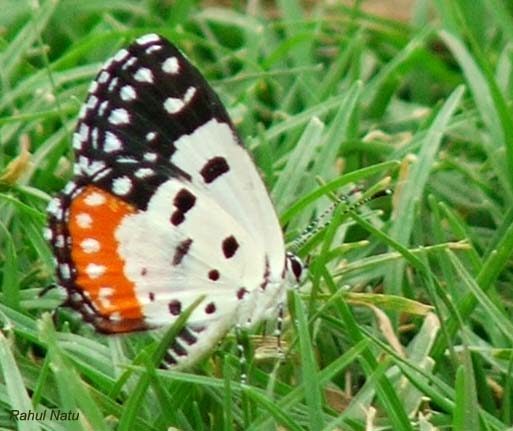- Talicada nyseus
image_width = 180px
image_caption = Red Pierrot ("Talicada nyseus")
regnum =Animal ia
phylum =Arthropod a
classis =Insect a
ordo =Lepidoptera
superfamilia =Papilionoidea
familia =Lycaenidae
genus = "Talicada "
species = "T. nyseus"
binomial = "Talicada nyseus"
binomial_authority = (Guerin, 1843)The Red Pierrot ("Talicada nyseus") is a small but striking butterfly found in
South Asia andSouth-East Asia belonging to the Lycaenids or Blues family. Red Pierrots, flying weakly around and perching on the Kalanchoe plant, are usually noticed by excited children in gardens due to their beautiful striking patterns and colours.Description
The butterfly with a wing span of 3 to 3.5 cm. The upper side of its wings are black except for a large portion of the lower edge of the hind wing which is orange.
On the underside, the forewing is white with black spots more toward the margin. The hind wing is very striking, it is white with black spots toward the base and the margin has a wide band of orange with white spots. There is a lot of variation found in the blacks spots on the hind wings.
Technical description
:"For a key to the terms used see Lepidopteran glossary"
Range
Sri Lanka ,South India ,Meghalaya ,Assam , NorthMyanmar .tatus
Locally abundant. Widely distributed in Peninsular India, and has been recorded from many localities in
Maharashtra ,Karnataka , andOrissa . Also found in the hilly regions of NE India and northernMyanmar . Studies suggest that they may be on the way to colonizing the foothills of theHimalayas due to changes in the habitat. [Singh, A. P. (2005) Initial colonization of Red Pierrot butterfly, "Talicada nyseus nyseus" Guerin (Lycaenidae) in the lower western Himalayas: An indicator of the changing environment. Current Science 89(1):41-42 [http://www.ias.ac.in/currsci/jul/41.pdf PDF] ]Habitat
Found in semi-arid plains, degraded patches of evergreen patches, and semi-evergreen forest, gardens, hill stations and forests , in fact wherever its foodplant, "
Kalanchoe ", is abundant. It is found from the plains to 8000 feet.Habits
The Red Pierrot is a weak flier, and flutters about close to the ground. It flies in short bursts and settles often but not for very long. It basks with its wings half open, but prefers shade to sun and jungle or undergrowth to open areas. It keeps on the wing almost till dark when it settles on the undersides of leafs and twigs often in company. It is sluggish early in the morning and late in the evening.It visits flowers of herbs especially of the
amaranthaceae andacanthaceae family fornectar . It visits both ornamental and wild flowers and varieties of "Alternanthera " are among its favourite.It always sits with its wings closed to display the bright markings of its undersides. It fearlessness, weak flight and distinctive markings all indicate that it is a protected butterfly, which is peculiar considering that its hostplants are not known to contain any sequestrable toxins.
There is a mention in literature of the species being found at lights at night, however such phenomena are usually restricted to species that are crepuscular and this occurrence may be incidental. [Usman, S., 1956. Some insects attracted to light. Part III. Journ. Bombay nat. hist. soc. 53: 482-484] [Donahue, Julian P. 1962 OBSERVATIONS AND RECORDS OF BUTTERFLIES ATTRACTED TO LIGHT IN INDIA. Journal of the Lepidopterists' Society]
Life History
It is not a common butterfly, but near its food plant, "
Kalanchoe ", it is found in abundance and is gregarious in all its stages.Egg
The female lays eggs on the underside of a leaf. Young and old leaves are selected without discrimination as the leaves of Kalanchoe are thick and
succulent during all stages.Caterpillar
The caterpillar is pale yellow to a dirty white, and flattened with large, jet black
spiracle s. The entire body is covered with tiny whitesetae or bristle-like hair.This caterpillar is a leaf miner by habit and this serves as its defense. As soon as it hatches it bores into the leaf and will spend the rest of its life between the epidermal layers of the leaf. Occasionally it will change leaves.
The caterpillar tunnels through the entire leaf in a neat winding manner so as to make sure to consume the entire leaf. It leaves a black trail within that is filled with droppings. The caterpillar can only be seen when it is changing leaves or when it comes to the surface to pupate.
Pupa
At the time of pupation the caterpillar comes out of the leaf and weaves a silk pad and a tight body band and then moults to form the pupa. The pupa can be either on the under or upper surface of the leaf. It is yellow and covered with long light hairs. The pupa is also marked with numerous black spots all over the body.
Foodplants
The larval host plants are "
Kalanchoe laciniata " and "K. pinnata" of the family "Crassulaceae " (Stonecrop family); the latter host being a common garden plant. Adult butterflies have sometimes been seen to visit lichens. Studies suggest that they collect phenolic substances by scraping lichens. [Karunaratne, V., Bombuwela, K., Kathirgamanathar, S., Kumar, V., Karunaratne, D.N., Ranawana, K. B., Wijesundara, D. S. A., Weerasooriya, A. and E. D. De Silva (2002) An association between the butterfly "Talicada nyseus" and the lichen "Leproloma sipmanianum" as evidenced from chemical studies. Current Science 83(6):741-745 [http://www.ias.ac.in/currsci/sep/741.pdf PDF] ]References
ee also
*
List of butterflies of India (Lycaenidae)
*List of butterflies recorded from the Western Ghats, IndiaExternal links
* [http://internt.nhm.ac.uk/jdsml/research-curation/projects/hostplants/list.dsml?searchPageURL=index.dsml&Familyqtype=starts+with&Family=&PFamilyqtype=starts+with&PFamily=&Genusqtype=starts+with&Genus=Talicada&PGenusqtype=starts+with&PGenus=&Speciesqtype=starts+with&Species=nyseus&PSpeciesqtype=starts+with&PSpecies=&Country=&sort=Family HOSTS database, NHM, UK]
* [http://www.arcbc.org/cgi-bin/abiss.exe/spd?tx=LE&spd=2445 ASEAN biodiversity database]
Wikimedia Foundation. 2010.

